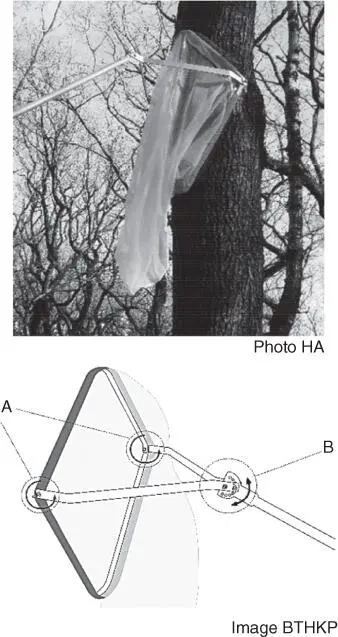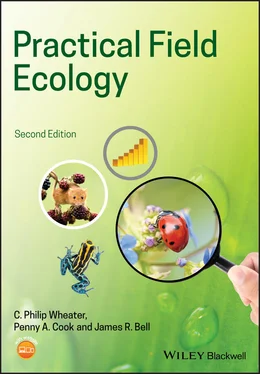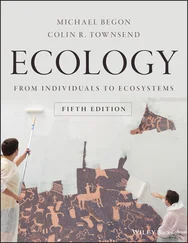Monitoring population sizes and density
In population and density studies, it is the number of plants or animals of particular species that is of importance. Such studies may look at the number per unit area (i.e. the density) or calculate estimates of population sizes. Densities are taken from the estimated population size divided by the size of the area sampled. However, for mobile organisms it may be difficult to identify the spatial limits of the population (e.g. in studies of butterflies, some species may be highly mobile with individuals not being restricted to defined small sites). Under such circumstances, densities may be less useful than estimations of population sizes of the animals using particular sites. If populations of several species are being studied, then it is important to ensure that the sampling methods used are appropriate to all the species being monitored. For example, in rainforests, some species of butterflies are found mainly within the canopy and are only occasionally caught at ground level and, conversely, some are predominant at ground level. Clearly, any survey comparing such study sites should incorporate sampling at both levels.
The spatial distribution of organisms can also be of interest, whether that is of static organisms (see Chapter 3) or more mobile individuals, populations, or communities. In the latter case, movement obviously complicates the monitoring techniques. It is often the case that individuals (and indeed populations) are restricted to defined areas either because of limits to their ability to disperse and colonise, or because of resource limitations (including competition between members of their own or other species). Biogeographical studies can provide information about distributions in geographic space and over time, whilst a landscape ecology study would look at spatial patterns over a range of scales in relation to landscape function and processes. At the smallest scale, individual home ranges and territories can be studied. Plotting the movements of animals diurnally and seasonally can indicate how individuals and groups of individuals make use of the environment in which they live.
Monitoring community structure
Another type of study of interest would be to establish the structure of the community of a specified area or habitat type (e.g. the community of fish in a lake, or the community of insects inhabiting a certain species of tree). Such studies may involve sampling a large range of quite different organisms. Organisms differ in size, distribution (both spatially and temporally), their use of microhabitats and, in the case of many animals, mobility. As such, care needs to be taken to ensure that the methods are as comprehensive as possible and are not biased towards or against any particular species or groups of species. For example, sieving soil to examine the communities of animals living within different layers (leaf litter, humus layer, the ‘A’ horizon of the soil, etc.) may underestimate larger animals that are found at low densities (e.g. large ground beetles), and may overestimate species that are found in large aggregations if sampling happens to coincide with these groupings (e.g. some woodlice). Several different techniques may need to be used together during a single study in order to obtain a broad understanding of the community structure of such habitats.
Studies on animals may involve monitoring the behaviour of individuals, even if this is not the primary purpose of the study. Knowing whether rabbits are feeding, being vigilant for predators, etc. may be useful if numbers are being counted in particular sites. Of course, other research projects will focus primarily on animal behaviour. Such behavioural studies may involve the observation of a number of individual animals in a variety of settings, or the interactions that animals have with others of the same, and/or different, species. Activity levels and habitat/resource utilisation may change with time of day and season according to changes in the weather. Assessing the time that individuals devote to different behaviours (time budgets) can help to identify such changes. It is essential that the location and methods used by the observer do not influence the behaviours being monitored. Working too close to large mammals with young may mean that the major behaviour monitored is vigilance directed against the observer – and may be dangerous for the researcher. Behavioural changes may occur even with subtle changes to the environment, such as the use of head torches. The emitted wavelength of white light attracts flying insects like moths, but changing the torch to red light solves the problem. What this does show is that all actions in the field, however apparently trivial, need careful consideration before fieldwork begins.
Whilst focusing in on the main aim of the research will help you to formulate the procedure to be followed, you will also need to understand the limitations of the approach that you take. For example, census methods (such as simple species counts) can be quick to implement and provide substantial amounts of data in a short time. In contrast, techniques to assess population sizes or community structure tend to be much more time consuming and may produce complex data sets. However, you should be aware that whilst it is usually possible to extract census information from population or community study data sets (albeit with a loss of detailed information), it is not possible to use census methods to assess community structure or population levels. In general, it is important to have at least some knowledge about the ecology and behaviour of the species or community under investigation when designing the research project, irrespective of the type of study being undertaken. Understanding the limitations as well as the potential benefits of any technique employed is essential to being able to critically evaluate the data gathered. As such, refining and developing new and existing methods can avoid or, at the very least reduce, biases and other problems with particular techniques. Case Study 1.1describes one particular example of how a novel technique was developed.
Case Study 1.1 The development of a novel net for sampling bats emerging from tree roosts

BTHK Tree‐roost Net in situ . A schematic showing the pivot points to adapt the BTHK Tree‐roost Net ensuring optimum positioning against the tree.
Henry Andrews is an ecological consultant and the founding member of the Bat Tree Habitat Key (BTHK) project ( http://battreehabitatkey.co.uk). The BTHK project was set up to achieve several objectives: (1) to establish the full range of different features of trees used by bats for roosting; (2) to understand which species used which features, when they used them, and how they used them; and (3) to build an app to help fieldworkers assess which species they might encounter in potential tree roost features. This case study describes the development of a new net by Henry Andrews of the Bat Tree Habitat Key project and NHBS Ltd to allow the user to sample bats emerging from tree roosts safely. This work involved a number of contributors: Henry Andrews, Katharine Clayton, Oliver Haines, Thomas Hamilton Koch, and Steaphan Hazell.
The BTHK Tree‐Roost Net is supplied by NHBS Ltd ( https://www.nhbs.com), a company that manufactures standard and bespoke marine, freshwater, and terrestrial survey tools.
Model organism and research challenges faced
Читать дальше













